Turquoise Energy News Report #184
Covering
September
2023 (Posted October 13th 2023)
Lawnhill BC Canada - by Craig Carmichael
[CraigXC at Post dot com]
www.TurquoiseEnergy.com
= www.ElectricCaik.com
= www.ElectricHubcap.com
Month In "Brief"
(Project Summaries etc.)
- Just Thinking About Home Heating - Cabin Construction &
Troubles - A Different Car Motor Project - Magnetic Variable
Transmission/Miles Truck - Nissan Leaf Turns 100 - Fake "Copper" Wire -
EV
Fires
In
Passing
(Miscellaneous topics, editorial comments & opinionated rants)
- Life on the Moon??? or ??? - Scattered
Thots ( Updates: - Tinnitus - Hair Loss/Gain: Mites gone! - Eyelash
mites - Population
- Changing Borders: China, Ukraine ) - ESD
- Detailed
Project Reports
-
Electric
Transport - Electric Hubcap Motor Systems
* Miles Truck & Magnetic Variable Torque Converter - for now: Fixed
ratio Drive
Other "Green"
& Electric Equipment Projects
* Cabin Construction
* September's Gardening
Electricity Storage:
Batteries [no reports]
Electricity Generation
* My Solar Power System: - The Usual Latest Daily/Monthly
Solar Production log et cetera - Monthly/Annual Summaries,
Estimates, Notes
This month my excuse for such a late report is that
relatives came to visit for the first week of October, my sister in law
and my nephew, and I did my best to show them around Haida Gwaii and
make space & time for them. We all enjoyed our time together and
outdoor exploring very much.
Just Thinking About Home Heating
I have solar in the day... then I want heat in the bedroom
at night and have to buy
the power. With only 4.3 KWH of battery storage it would be a bit
futile to simply run an
electric heater off it... still, if one could save even a couple of KWH
per night and recharge the next day, it would dampen the electric bill
a bit - at least in autumn and spring. When I get the 300 AH LiFePO3's
I've ordered it'll be 10.8 KWH. That's about
all the solar system is recharging in a day even in September anyway.
Heating off solar/battery would be more feasible if I ever
get that open loop air heat pumping working and getting anything like
that projected COP of around 10. The "R" of this among several projects
is well ahead but the neglected "D" of "R & D" wants time and
effort if things are to be made actual rather than just theoretical or
sketchily tested...
Cabin Construction & Troubles
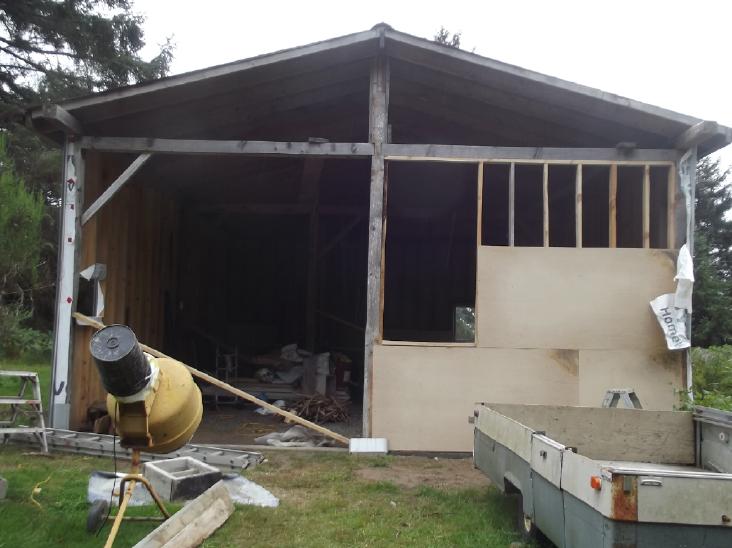 Sheathing 2nd Last wall section,
Sept. 4th
Sheathing 2nd Last wall section,
Sept. 4th
(Apparently this is all about me, down to the next
image...) Early in the month the drill slipped and put the
screwdriver bit into my thumbnail, hard, right at the cuticle. (I'm
usually careful to keep my other hand well clear, but I was on top of a
ladder trying to put in
the first screw in the top board while holding it up. and pressing
really hard to try
to keep the bit from jumping out. It jumped. The good news was I didn't
fall off
the ladder.) I'm still not
sure what will happen
to the thumbnail. half of it looks good. Then on the 11th I ate a piece
of
chicken from the freezer - the second one of two from that bag,
butchered and plucked in 2021. The first piece was delicious. Probably
I
didn't cook this one long enough. On the 12th
I got diarrhea and lost over a week on most everything while the
weather got colder and wetter fr outside work. (Oddly a couple
of others were saying similar. But surely for me it was the chicken?)
I finally went back to work on my cabin on the 21st, and
it quickly turned into "one of those" work sessions. Suffice it to say
that after 5 hours I had a 2 by 4 screwed into place.
On the 26th I looked at my thumbnail with a powerful
magnifying glass with a light on a stand (a "milliscope"?) and
discovered that it had split
into four sections. The left half was fine as was the rightmost end. In
the middle there was a crack that went half way along the nail
toward the front. Second to the right was a piece growing out next to
but cracked away from the right and from the part farther grown out -
nothing holding to the rest. In the middle was a short piece of nail
growing
upward out of the thumb instead of forward from the most damaged part
of the cuticle, and of course a wide gap in front of that between the
two halves. I pushed everything into place as best I could and glued it
all together with cyanoacrylate glue. Here's hoping...
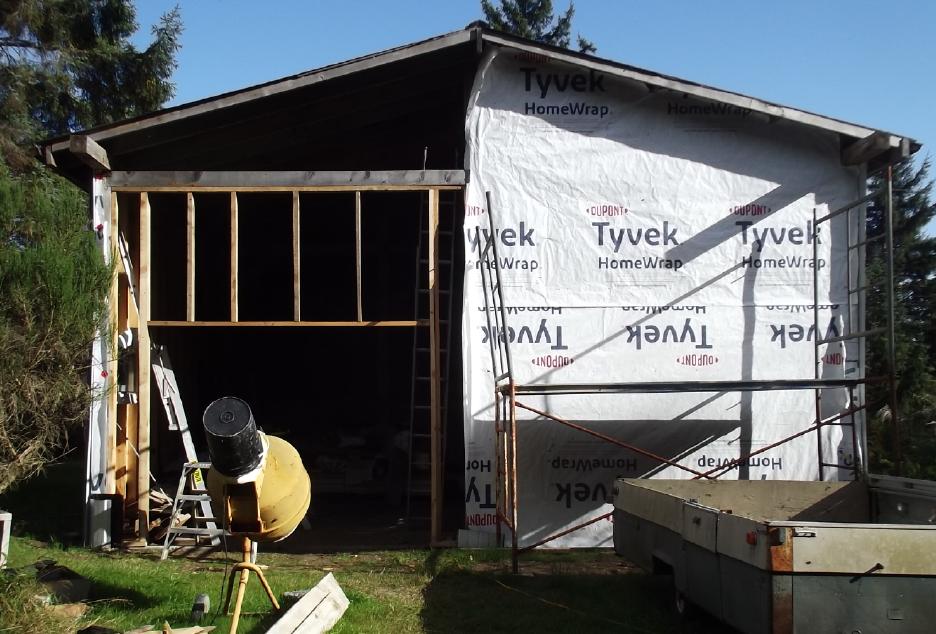 On the 27th I finished framing the last main wall section with
a 7 by 9 foot opening for a roll-up garage door. I spaced four 2 by 4s
over the door frame to get relatively even spacings. But
they were badly mismatched for sheeting with 4 by 8 foot plywood, so I
took them off
and redid them. Then a
deluge of rain stopped me from putting up plywood. It turned out that
was just as well.
On the 27th I finished framing the last main wall section with
a 7 by 9 foot opening for a roll-up garage door. I spaced four 2 by 4s
over the door frame to get relatively even spacings. But
they were badly mismatched for sheeting with 4 by 8 foot plywood, so I
took them off
and redid them. Then a
deluge of rain stopped me from putting up plywood. It turned out that
was just as well.
I found a
double-glass window pane that looked suitable for the second floor
gable end window at the refuse station.
Somehow I wrecked up my tennis elbow/tendonitis/whatever
again. Just snapping my
fingers or something. I'm about ready to cry! Using the staple gun or
anything with a sudden snap or hit seems to do damage. (In October I
found out about "Ulnar Nerve Flossing" with videos for exercises on
youtube. They seem helpful.)
If the garage
door was 7 feet tall, the ceiling had to be 8 feet to accommodate the
rails and hardware. That extra foot would make the upstairs too low to
stand up in except near the peak of the roof. Presently my thought is
to chop about 11 inches off the bottom of the door and rails, and maybe
use 4 by 4s for the upstairs floor joists over the rails instead of 2
by 6s. That would give a foot
more height upstairs, and still 7 feet in the garage except for the
doorway (6'1") and where the
rails were. That would be tall enough - for me. (Sigh, I need to frame
above the door for a third time, 11 inches longer?) Trespassing on
October since it's half over, I finally ordered a door on October 10th
after much looking around and being quoted prices of 2000 to 3000$. It
was at Home Depot in Prince George for just ~900$. In September the
website had said "5 in stock" until I went to order one. Then it said
"out of stock". On October 10th I looked again and it said "1 in
stock", which the sales clerk verified. I ordered it, having meanwhile
figured out that I could get "Dun Rite Dave", the guy who was
delivering the LiFePO4 batteries, to also pick up and deliver the door
on the same trip at the end of October.
A Different Car Motor Project
The unipolar axial flux BLDC motor and 6-phase controller
is a somewhat daunting project. A less innovative one but simpler, with
better short term prospects for completion, sprung to mind in early
September: Rewind
my old 7.5 HP, 3600 RPM sawmill motor for 36-40 volts instead of 230,
and run it in the Chevy Sprint with the 550 amp Curtis AC motor
controller (from the Swift, sitting all this time idle in storage). No
doubt it could do 15 HP for short bursts of acceleration or hill
climbing, and 3600 could be stretched to 4000 RPM. The car should have
sufficient torque to start and go up hills with the present 5 to 1
planetary gear. Since each phase has six slots and 230V/6=38V, the
change would simply be to put all six sets of slot wires of each phase
in
parallel instead of in series. For 7.5 HP, 24 amps at 230V would become
144 amps at 36V. 15 HP would be 288 amps, still doable by the motor
controller, which in fact at such a low voltage should be well under
its
power ratings. The present forklift motor is about 5-1/2 HP at highest
power. 15 wouldn't make the Sprint a "muscle car" by any means, but
with such a
light car I think it should put it on the road, and I expect it would
average well under 7 HP on the highway.
4000 RPM / 5 is 800 RPM to the wheel, which is 80 Km/Hr
for the highway. (Another possibility is to put this motor and
controller on the right rear wheel of the Toyota Echo via a chain and
sprockets and turn it into a hybrid. I did once buy a special 120 tooth
#40
chain sprocket gear to put on a wheel for just such a project. Hmm!)
(In 2006 I rewound the motor as single phase with starter circuit to
plug into the dryer plug for the sawmill. The handheld bandsaw mill
[see TE News issues from 2018 and a few 2019 or 2020] is better so I
really have no more use for the old mill. This reminds me of a UVic
[Mechanical Engineering?] project in (?)2008. I just happened to be at
the counter in Troy Electric when they brought in a motor to have Troy
rewind it to a lower voltage for an EV project! Wouldn't it have been
better to have students learn how to do it themselves like I did?)
Magnetic Variable Transmission/Miles Truck
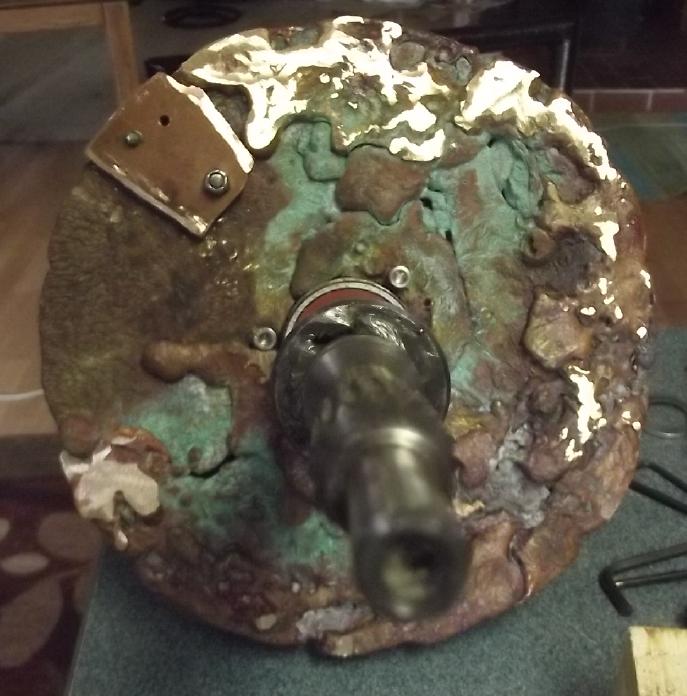 I
replaced the magneticly troublesome steel weight with a copper one. But
when I put it back on, again there was a lot of vibration. I mounted a
camera to get a video of the mechanism working.
The vibration was different this time: as I
pressed the pedal and the truck started moving, I could see the magnet
rotor/body of the planetary vibrate around radially, as if it was
getting more torque some rotations than others as the copper disk and
the magnet disk turned WRT each other. Magnetic torque ripple! But more
like torque "breakers" than "ripples". No such phenomenon was observed
with the smooth alume alloy rotor. The poured copper rotor is nothing
like smooth, but with six magnet poles per rotation and "random"
lumpiness I thought it would all balance out. Instead I think if I
tried to drive anywhere it would surely shake until something came
loose or broke.
I
replaced the magneticly troublesome steel weight with a copper one. But
when I put it back on, again there was a lot of vibration. I mounted a
camera to get a video of the mechanism working.
The vibration was different this time: as I
pressed the pedal and the truck started moving, I could see the magnet
rotor/body of the planetary vibrate around radially, as if it was
getting more torque some rotations than others as the copper disk and
the magnet disk turned WRT each other. Magnetic torque ripple! But more
like torque "breakers" than "ripples". No such phenomenon was observed
with the smooth alume alloy rotor. The poured copper rotor is nothing
like smooth, but with six magnet poles per rotation and "random"
lumpiness I thought it would all balance out. Instead I think if I
tried to drive anywhere it would surely shake until something came
loose or broke.
A good sign was that as the truck just started to move at
"idle" speed, the
planetary body was largely stationary instead of turning backward.
(Well, at least averaging stationary as it shook back and
forth.) That seemed to indicate that with just ~1/4 inch copper instead
of inadequate
1/2 inch alume alloy, the magnetic coupling to the Hallbach configured
magnet rotor is balancing well with
the torque
needed to move the truck. The RPM of the slip would be lower at all
points and the motor would never be turning so much faster than the
input
to the planetary - that magic "78 RPM" maximum slip I was mentioning.
(I don't think that could be brought down to "45" or "33-1/3 RPM", or
that that would even be desirable. Or that young people will know what
these RPM references refer to.)
This rotor at least has demonstrated that the magnetic
force interactions can easily be made sufficient in production
and the magnetic torque converter should thus be practical in
actual use.
Also learned: the excessive vibration from the magnetic
cogging
eliminates the idea
of having steel pieces cog to magneticly lock the rotors together at
lower torques: the radial vibrations from that would doubtless be much
worse than those
from just thicker and thinner regions of copper. Anything to lock and
unlock the rotors would have to be an active control - or perhaps
centrifugal. Oh well, 1078 RPM (78
RPM slip) at 1000 RPM of the body (city street) is theoreticly 93%
efficiency anyway. At
2000 RPM (highway) it's 96%. (Actually, a centrifugal lock should work
quite well and make it 1 to 1 ratio and 100% theoretical efficiency
driving at roadway speeds, but I don't intend to try making a mechanism
for it on my prototype.)
I'm running out of steam for this project. Too many things
to do! I've proven it works and should be practical in
production.
What next? Well, duh! I could just put the 5 to 1 planetary back on,
with the body
clamped stationary. At least the truck would be running again and could
go places.
No matter how I do it I think I'd be reluctant to drive this truck over
about
65 Km/Hr, which speed doesn't actually need the torque converter with
this
motor although the RPM would getting up there, around 7000 RPM.
That should be good until such time as I have a new copper
(or pure alume?) rotor to try out. That
won't be changing hardware to something incompatible or making it
any harder when I get
to it, but it will be putting it off until some more propitious future
time when I have a decent rotor to install. Who knew that a simple
metal disk would be a big stumbling block?
I'm thinking about
making a special furnace with propane or oxy-hydrogen [per TE News #183
or was it #182] to cast a whole 10 by 10 inch rotor inside itself, in a
single melt, and then just let it cool inside the furnace. No pouring
liquid copper. Still the question is, when?
Having now made the housing with the steady bearing
holding the shaft, the 5 to 1 gearbox shouldn't start that awful
vibration that I had
mistaken to be imbalance in the shaft assembly when I first put it on.
I pulled the assembly out from under the truck - yet again
- and and removed the gearbox and then the copper rotor. Then I dug out
the 5 to 1 gearbox. The only new thing it would need would be a
mounting to prevent the body from rotating in the housing. Later I
found the two original mounting pieces, which I should determine the
alignment of and weld together rather than bolt.
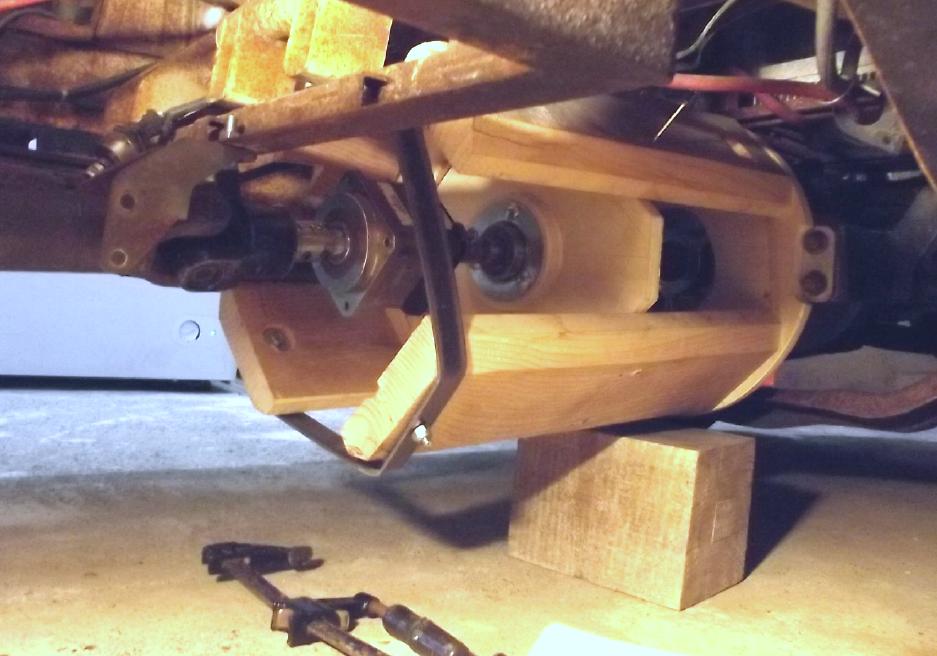 [23rd] I put the drive
shaft with gearbox together and into the truck, and put in a long
C-clamp across the body of the
gear since there was nothing to stop it from spinning. It was all I
could do to hold the "idling" truck stopped with the brake. It hopped
over a 2
by 4 blocking the wheel even with my foot still on the brake. Okay!
When I
pressed on the pedal it bent the C-clamp and pushed it
away.
[23rd] I put the drive
shaft with gearbox together and into the truck, and put in a long
C-clamp across the body of the
gear since there was nothing to stop it from spinning. It was all I
could do to hold the "idling" truck stopped with the brake. It hopped
over a 2
by 4 blocking the wheel even with my foot still on the brake. Okay!
When I
pressed on the pedal it bent the C-clamp and pushed it
away.
After it's mounted, I'll
definitely
need to find why the
programmer won't connect to the motor controller, and then change a few
important parameters in the program - like reduce the idle torque as
well as allow higher motor speed. (I suspect Miles deliberately cut
a wire to keep anyone from
altering the settings. If so, yet more stupidity on their part.)
Nissan Leaf Turns 100
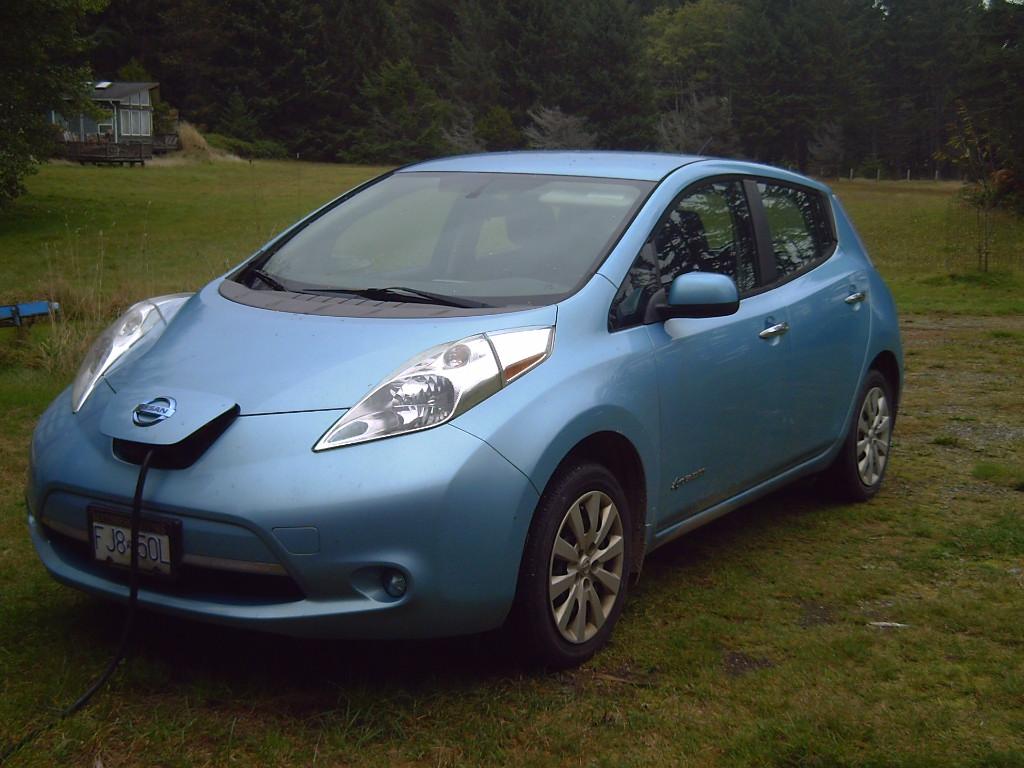 My 2015 Leaf
EV now has 100 megameters on it. In the
summer
weather and as the Bridgestone Ecopia
'low
rolling resistance' tires have 'worn in', the car has definitely been
using less
energy per kilometer. On my most frequent trip, driving to town and
back almost 55Km, with the old tires the
most the car ever had was "58%" battery charge left - usually "52" to
"54" in
summer, more often well down into the "40%"s in winter. Now sometimes
it has been
even over "60%",
notwithstanding that the "battery health" on the 8 year old car is down
from "12 bars" to "11 bars".
My 2015 Leaf
EV now has 100 megameters on it. In the
summer
weather and as the Bridgestone Ecopia
'low
rolling resistance' tires have 'worn in', the car has definitely been
using less
energy per kilometer. On my most frequent trip, driving to town and
back almost 55Km, with the old tires the
most the car ever had was "58%" battery charge left - usually "52" to
"54" in
summer, more often well down into the "40%"s in winter. Now sometimes
it has been
even over "60%",
notwithstanding that the "battery health" on the 8 year old car is down
from "12 bars" to "11 bars".
The "Km per KWH" reading used to surpass 8.2 or
better while I was driving in town, but it would drop to maybe 7.5 by
the time I
had driven home on the highway again. Now in warm weather sometimes
it's still over 8
when I arrive home. And it's higher up in the 7.x range (well above
around 6.8-6.9) on a pure highway drive.
The new record this summer is "66%" left,
obtained twice after driving to town again shortly after recharging
from the first time. (Perhaps the battery performs better when it's
still
warm from charging?) "57%" to "62%" left is more common, at least
partly depending
how fast I drive on the highway. And of course it uses more battery if
I
do much driving around in
town,
like to the building supply store toward the far end.
As I've noted
previously the rolling resistance seems to rise markedly below about
12°. So the economy reduces considerably as the weather cools and
the pavement is often wet. Last winter it was often down into the "40"s
ranges going to town and back. But it's done so well this summer that
I'm expecting some
economy increase this winter. I now see the economy dropping a bit as
the
weather cools, but it's still pretty good - in temperatures that
are still two digits so far.
In spite of various "pickup truck" type uses, the car
still looks very nice when washed and vacuumed, and everything still
works except a new tire pressure valve-sensor isn't set up, so a light
comes on on the dash. The tire was leaking at the original valve. I
also had to change the rear brake pads and disks a year or so ago. The
inner and outer pads on one side were apparently reversed causing them
to press
diagonally - seemingly a factory mistake that probably wore it out
prematurely. Then again, they use a lot of salt and gravel on this
highway in winter.
No doubt it's well that I've had no other trouble, since
there's no Nissan dealer or electric car garage on this island.
Fake "Copper" Wire
A couple of years ago I looked on line for #18 or so wire
for various hookups. It seemed to be about 12$ for 50 feet including on
AliExpress. But the local "Your Dollar Store with More" had it for 6$.
I
bought 4 or 5 packages.
One day a length of one went near a magnet... and stuck on! The wire
wasn't copper! It looked like copper because it was copper
plated. Of course it never occurred to me anyone would make wire that
wasn't copper unless it was clearly stated. I guess I got what I paid
for, but the deceit can be more than just "so what?" if you're
expecting low resistance.
I've made a couple of 36V cords from it, including a 7m
extension cord. I measured its resistance at about
1.3Ω. This makes the #18 wire about 57Ω/1000 feet instead of 6.4Ω/1000
feet. The flat panel work
light I usually power through it isn't as bright as it should be - 15W
instead of 20W. It was only sold
as "speaker wire", but an ohm or two
is a notable percentage power loss even going to an 8 ohm speaker.
The price of copper is rising. Might other "fake" wire
start appearing?
EV Fires
According to a video on YT by "Tech Charge", an EV has a
.3% chance of catching fire, while a gasoline vehicle has a 1.05%
chance. That should make EV's safer but for the fact that battery fires
are
so intense and so difficult to extinguish. The intensity means they
will light up other closely parked vehicles, or a building they are
in or near. The difficulty extinguishing is owed to the fact that both
components being consumed are inside the same battery cell. Pouring
thousands of gallons of water on it may cool things and prevent spread
but it won't stop
the combustion. (AFAIK they just might even burn under water.)
The biggest cause of EV fires is said to be short
circuits, leading to catastrophic currents and rapid heating of the
cells. Next is other reasons for overheating, including starting a
charge while the batteries are already hot from hard running. (I
imagine the worst would be if you live at the top of a mountain and
always plug in when you race home. Or maybe living just off a 120 KmPH
highway in a hot climate.)
The worst cars are Chinese models, for various failures
related to quality and reliability as well as fires, led to my surprise
by BYD. In 2017 BYD's proud policy was to use somewhat heavier but
safer lithium iron phosphate cells they produced themselves, maximizing
cycle life and reliability over performance. They considered lithium
ion cells too dangerous. They were making industrial vehicles (buses
& "cube vans" and fleet cars) then, not yet cars for consumer
purchase.
Now their cars have "blade batteries". These are lithium
iron phosphate, but rather huge cells: almost a meter long by 9cm wide
(thickness wasn't specified where I read it.) They passed all safety
tests, but in actual use have proven dangerous. But at least one of
their car fires was in the driver's seat, suggesting
bad wiring (seatbelt? seat heater?...) and hence shoddy design or
workmanship. Bad wiring could
make shorts that start fires anywhere, or cause the batteries to
overheat. (Where are the fuses?)
I had hoped that when Miles
went out of business the worst of Chinese shoddy vehicle manufacturing
had gone down with it. I guess not! (But Miles never made "regular"
cars.) Japanese - as well as European and North American - car quality
just looks all the more fabulous when contrasted
with Chinese.
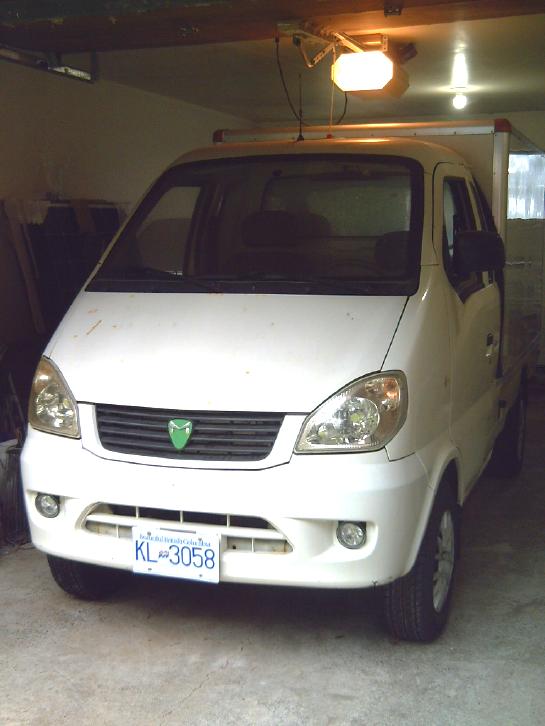 My Chinese Miles ZX40
Mini Cargo Van EV
My Chinese Miles ZX40
Mini Cargo Van EV
(Why is Miles out of business?...
I can't leave it outside because the body rusts so quickly.
Motor controller doesn't connect properly with programmer.
12V battery charger continuously drains main 72V battery pack!!!
...and several other electrical wiring mistakes!
and... replacing leaky brake lines by 2019 on a very low mileage 2009
vehicle?
Really?)
In
Passing
(Miscellaneous topics, editorial comments & opinionated rants)
Life
on
the Moon??? or ???
ISRO put its Chandrayan
III space probe into lunar orbit and landed the Vikram lander with the
Pragayan rover in an "Antarctic" area on Earth's moon. There has been
much
congratulation to India and ISRO and much description in videos of the
amazing
technical feat accomplished.
A temperature probe stuck into the lunar soil measured the
surface
temperature as +10°C but by a mere 10cm underneath it was something
like
-30° (IIRC). This indicates that the surface of the soil is a
really
good insulator.
The only other mention of the actual ground was that the
elaborate
"stamps" built into the tread on the rover's wheels didn't make nice
clean imprints in the tracks because unlike the dusty or gritty
equatorial areas visited by the Apollo astronauts, the "soil particles"
in
this antarctic area "cohere" together.
There seems to have been amazingly little interest so far in what the
cameras actually showed of the strange lunar ground.
 Surface of Earth's moon at -70's
degrees
latitude from Chandrayan III's Vikram lander, which here has
Surface of Earth's moon at -70's
degrees
latitude from Chandrayan III's Vikram lander, which here has
just completed a short hop-over to half a meter from its
original landing point - a successful extra
experiment in taking off and landing again. The tracks of the Pragayan
rover where it left the lander
are seen on the left. The right wheels
broke something long and thin like a "branch"(?) at
the rim of the crater it
passed, which was visible in the "before" images.
Okay... What is it? There are craters of course. But does
the surface
look like rocks and or dust to anyone? And is it all as drab as it
looks in monochrome, or are there brightly colored individual features?
To me it looks "mossy", tho only vaguely similar to a
patch seen close up on Comet 67P by that lander. But I would expect any
temperature where
ice would melt would be much too warm for what would seem to be
"Ganymedean" type airless world life, which seems to have migrated to
so many airless worlds
in the Jupiter-Saturn areas and beyond. Also it can't be ice crystals
--
at +10°C they would have melted and anyway water was not observed
in the surface spectra. Some other crystals that grow in lines,
perhaps? But they don't look very "crystaly" to me either. Predictably
but too bad the lander didn't come back to life the next day
(an Earth fortnight later). If it had lasted another lunar day or two,
would we see
that some of the material squashed down in the wheel treads had sprung
back up, or was it all delicately formed by some process that ended
long ago and will sit right where it is for millennia?
Quite a lot of sulfur was found (as on Ganymede etc), but
carbon and organic
material haven't been mentioned. Certainly no mention of polycyclic
aromatic hydrocarbons and "stretched" CO2 like on those outer worlds
and especially Iapetus, which was spectrographed by the Cassini's more
advanced instrument than the Galileo's inspections of Ganymede and
Callisto.
But what were Vikram's and Pragyan's instruments equipped to identify?
They were really looking for water ice. And why should this apparently
fluffy covering have such a high thermal insulation value? Is it in any
way similar to "fluffy" Ganymede, Callisto and "very fluffy" Iapetus?
(Only the non-irradiated leading hemispheres on Callisto & Iapetus
are fluffy. Ganymede has its own magnetic field with Earth-Like auroras
protecting both hemispheres from Jupiter's ionizing radiation.)
Yet again I must lament what a pity it is that ISRO, like
NASA/JPL, can't seem to afford proper color cameras (like I have
several of myself) to give us a clear picture of what we're looking at.
And how unfortunate that Russia's lunar lander (also this month)
miscalculated somewhere and became a lunar meteorite making a 40 meter
crater. At least the Soviet Union put color cameras on their Venus
landers and I would expect Russia today would do likewise for the moon.
(Think of this: the only reason the famous Voyager probes to the outer
solar system worlds had color cameras was because the the imaging team
found out there were two surplus color cameras left over from another
mission, and NASA couldn't think of an excuse not to allow them to use
them - even those bold pioneering missions were intended to have been
monochrome!
Think of all we would have missed of the exciting outer solar system
worlds, of how little interest those probes and missions might
have generated without the color images! The images are the meat in the
sandwich of all the other data - why skimp; why gloss over them?)
"A color picture is worth 1000 monochromes." -- me
Scattered
Thots
* Tinnitus (followup from TE News #183) The
Nicorette gum, chewed twice a day for two weeks, had no discernable
effect on my tinnitus. Only things related to damping of the ubiquitous
electric power line fields made any difference. Since I couldn't avoid
the fields full time (or even close), they had reduced it notably but
not stopped it. When I stopped using the mesh and the helmet, the
piercing high pitch tone
was soon as loud as ever. (...and that was a couple of days before I
finished the
last of the gum. I should have known the gum sounded too good to be
true. But it seemed worth a try!)
Grounding to my skin with a wire (plugged into the ground
pin of an electrical outlet) when lying in bed seemed to help a bit,
but grounding with an "Earthing Pad" I bought didn't, probably because
while it did technicly "connect", the measured resistance from the
surface of the pad to the ground pin was over 100,000 ohms - surely
pretty useless.
The relationship between power line fields and tinnitus is
by no means clear or direct. I'm probably wrong to think of it being
similar to radio reception where the ear mechanism is somehow picking
up the 60
Hz tone electricly (or acousticly), because the low tone can appear
whether or not I am in an electric field. When I heard it in bed, I put
on my metal helmet (grounded) and it continued, apparently
undiminished, just as
in the cabin and in the woods test late in the last report. So... not
direct reception of anything detectable.
But some relationship is evidently there, since my
tinnitus did
diminish with use of the mesh and the helmet over weeks, and with two
anecdotal stories of it disappearing entirely when
far away from power lines. (There was also a lady commenting on youtube
that she had had her bedroom made into a Faraday Cage to block electric
fields because she couldn't take the ringing all day and at night too.
She
didn't say, but it was implicit in the comment that it worked.) The
closest I see it is that the field agitates something inside the head
or
inside the ears, which then causes something in the head or ears to
start generating high, mid or low pitched ringing tones which are
perceived as audio
- seemingly similarly to having been exposed to too-loud noise for too
long, but in the absence of actual noise.
And that hearing loss somehow seems to make one susceptible, or far
more susceptible, to this process or phenomenon.
* Hair Loss/Gain - Mites gone! (followup from TE News #183 -- scroll
down to article) When I first started using alcohol on my scalp in
2019, areas
on top
where there had been hair loss became quite tender and 'sore' to the
touch. I assumed this meant inactive follicles were resuming activity
and growing hairs
with the demodex mites gone. The sensation faded in a couple of weeks
but my hair never returned to full thickness. And the mites just seemed
to keep coming back and coming back if I didn't keep treating them.
Wikipedia said that the
mites can't live off the host, but that turned out to be misleading.
Someone (on youtube) who seemed to have done much
research said they could live up to 52 hours! This explains how they
spread so readily from person to person, and puts a different
complexion on what is needed for treatment. That meant that I would
treat my scalp and kill all the mites, then soon after reinfect my
entire scalp at once when I put on my tuque, or lay down on my pillow!
So I started also taking steps to disinfect pillowcases,
tuques, hearing protectors, chair backs, hair brush and anything else
that contacted
my scalp at the same time as I treated my scalp. The areas where there
had
been hair loss became even more tender. "Disinfecting" items can
be by spraying them with alcohol
or simply by setting them aside for 3 or 4 days until the mites have
died by themselves before contacting them again. At the end of August I
started doing
this twice a week, but I only did it twice. I was very careful about
everything - bedding, tuques, ear protectors, top of chair backs and
hair
brush/comb. Then, not feeling well for a while I put off further
treatments. But
the "tenderness" in the "thinner hair" areas of my scalp started and
didn't go away in a couple of weeks. In just the two careful sessions
of scalp treatment and
cleaning, replacing or setting aside (4 days) everything my head
touched, I seemed to have already got rid of them entirely! After all
these years!
Hopefully I'll recognize if they start coming back. (At a millimeter
long I would think the mites should be visible with a magnifying glass
- "milliscopic" rather than "microscopic" - but your own head is a most
inconvenient place to look for anything small. A couple of commenters
said they can see them in a mirror and are bothered by them, but that
the doctors
tell him they're crazy and imagining things.)
One good and pretty sure sign: my fingernails can't find
any
little "scabbies", little hard raised bits of dandruff/skin that I
could
pick off my scalp with a fingernail. Those decreased greatly after I
started using alcohol once a week, but I could always find one here and
there. Now none. I think I will assume that the mites are gone until
and unless I start finding them again.
Well before the end of the month the tenderness diminished
and I became quite certain they were gone. What a relief! No
more 'scabbies'. No more keeping my head extra warm by wearing a tuque
everywhere even in summer, shampooing as often as possible and covering
my head in bed (as I was doing before the end of 2019) or frequently
spraying alcohol on my scalp (2020 on).
By early October I can say my hair is getting
thicker and pretty much covering even the rather bare area at the top
at the
back. (BTW: A mirror to see behind you in the bathroom is a valuable
thing!) It's all but a full head of hair now. If I part my hair in the
middle it now looks like a regular part. I no longer see a wide patch
of skin under sparse hair.
All is well until the next time I sit in someone's
infected sofa or easy chair or have close body contact with an infected
person (apparently most people) - and now I know what to do about it!
(I
certainly wouldn't use someone else's comb or hat!)
I mentioned killing demodex folliculorum mites with
alcohol and reversing hair loss to a couple of guys, one bald and one
well on the way, who said they didn't care. Now I'm becoming reluctant
to get too close to people. I foresee a day,
however far off, when having the mites and thinning hair will be as
socially unacceptable as having lice. Alcohol seems to work great, but
those who have taken the trouble to rid themselves of the mites won't
want to get too close to those who might reinfect or even repeatedly
reinfect them. Hopefully they will become extinct.
* Eyelash mites: The related Demodex Brevis mites (1/2
a mm long) are also easily contracted. After my relatives visited I
noticed little twitchings in my eyelashes when lying in bed. I had a
fairly long shower in which I closed my eyes and applied shampoo to my
eyelashes, and I left it on for the entire duration before I rinsed it
off. Then I changed my pillowcases and sprayed the head end of the
sheets with alcohol (not caring to change them at that point) to
prevent re-contamination.
No more eyelash twitchings, so I guess those steps got
them.
* Population Africa presently has around 1.4 billion people.
Depending on the criteria, 140 million to 275 million of this
burgeoning population - 10 to 20% - are now "food insecure",
"malnourished" or starving, especially in certain Sahel countries and
the horn of Africa. There are also major problems with food in
Pakistan, Sri Lanka, Bangladesh and other highly populated regions.
China is buying food globally with its serious crop failures, which
makes China's food problems everyones'. These shortages were already
starting to show before Covid and before the Ukraine conflict, tho of
course those have
made it worse. By and large there don't seem to be large stores of
excess grains in prosperous countries to fill the needs of the
desperate - and the majority of the people of most countries aren't
very prosperous any more themselves. As weather disasters continue to
intensify and randomly destroy crops left and right, and as we start
running short of the non-renewable resources that have enabled "green
revolution" big agriculture, shortages seem to be beginning to
gradually but inexorably become global.
Some are saying the population is leveling out, and the
fact of birth control allowing all families to be wanted families with
fewer children instead of accidental with more children than desired
does indeed bring great hope for a prosperous future with a stable
population. But that's looking past the immediate future. Nine billion
people is probably triple what the planet can sustain in the long term,
and it looks like we are now starting to pay for having such a human
algae bloom. The coming years and decades are bound to be severe.
* More Changing Borders I recently found/showed a map of what
Canada looked like 100 years ago. Here's one showing all the lands
incorporated into modern China since WWII. We see that communist China
has
actually been quite imperialistic having doubled its territory and
more. It has just now drawn a new map claiming new lands
on their borders, including Kazakstan or part of it, bits of India and
an island in
a river between Russia and China previously agreed to be co-owned.
(Let's not think about Taiwan!) PS: Shingjiang is also known as East
Turkestan. A lot of people there have resisted becoming and being part
of China. (I'm not sure why neither China nor Russia have taken
Mongolia. I think there are videos explaining it.)

Then we might also look at Ukraine, which grew over the centuries from
a small region
of Russia into a very large territory with that name - not by conquest
or even assertiveness but simply for the administrative convenience of
successive Czarist and Soviet administrations. The Eastern territories
transferred to Ukraine by Lenin and Khrushchev were and are mostly
populated by
Russians. The Western piece added by Stalin was mainly Polish. At the
same
time Stalin transferred to Poland part of Eastern Germany, took German
East Prussia for itself and called it Kalliningrad, and there
was much migration.
Of course one also notes that the purple portion is mostly
inhabited by Russians and is essentially the area of the present
dispute, which intensified in 2014 when the elected government was
violently
overthrown, Russian language was banned by Kiev in schools and public
offices,
and three provinces including Crimea broke away along with a third of
the Ukrainian army.

* Why are "0" keys next to "9" instead of next to "1", as if an
afterthought? I thought we had abandoned Roman "no such number as zero"
times.
How the Ukraine Conflict Might End? All summer Ukraine has been
throwing its lifeblood, and that of various foreign mercenaries, into
the much hyped counteroffensive against the
by now well prepared Russian defenses. Neither side has gained or lost
much ground. But the Ukrainian army and its lavishly supplied Western
equipment are now well depleted and there are signs that the Russians
may soon launch their own offensive in the northern area, at least up
to the Oskil river.
But the Russians have adopted a new tactic: dropping
leaflets on the front lines and opening a radio channel. The leaflets
give the Ukrainian forces a procedure for how to surrender and assure
them of humane treatment and good food. That's more than they're
getting on the front, where tens of thousands have been killed this
summer. (Total since February 2022 may be 300-450 thousand, and many
more wounded and unable to fight.) The radio channel (or was it actual
radios?) is so they
can contact the Russians and tell them they wish to do so any time.
About the end of September I
heard that 10,000 had surrendered en masse, which is a few percent of
the entire
force. Most of Ukraine's original force is long gone. Certainly not all
of these new and semi-trained "cannon fodder" conscripts are ardent
nationalist
neonazis! Perhaps soon the issue may be out of the hands of the
warmongers and arms merchants in Washington, London and Kiev? Ukraine
has now become panicked about mutinies and doesn't allow large
concentrations of its troops to come together.
(But so far there have been no more mass surrenders, and I
even wonder if the story is true or if I really read it right?)
* Former New Zealand prime minister Jacinda Ardern has said "we" need
to "crack down on freedom of speech". If ever there was such a thing as
blasphemy in the modern context, surely this is it! This is treason,
not against a specific nation or group, but against the rights of all
men as a whole. Many have fought and died for the right to speak their
mind - and be heard - without fear of retribution.
Unfortunately she isn't alone. It brings us the whole
war against journalists, bloggers and indeed many highly qualified
scientists and doctors - anyone who doesn't tow the hypnotizing "mass
formation" political
narratives lines, shutting them out from all the channels they should
be able to use to make their views known to the public and even jailing
and murdering some of them.
Who is "we"? Why do these people think they are qualified
to be arbiters of
what is
permissible to be thought and said by others, when everyone's knowledge
and views
are ever
changing? Why do "we" give such manipulative people the right to
trample on our rights?
ESD
(Eccentric Silliness Department)
* What happens in a pharmacy? Pharmers are busy pharming.
* Dad's Cookies "since 1929" ----
Shouldn't that be Great
Granddad's cookies by now? (How stale are they?)
* Today's Special: Rabbit Soup ----
Customer:
"Waiter,
there's
a
hare
in
my
soup!"
* Funding Gnat Seas ---- Why should gnats need so
much water? And what do we care about gnats anyway? Anyway, no
doubt our government has our real best interests at heart when they
fund
those instead of trying to solve Canadian problems.
* What does "exorable" mean?
* Why is "pie" just a piece of "piece"? Something is backward.
* The unsuspected cause of global warming. It is said that in the 1500s
they burned witches who were suspected of causing bad weather. In the
past century sea level temperatures have been rising and lately extreme
weather events have been occurring with with accelerating frequency.
Why? Obviously because we stopped burning witches! Cause
& effect. QED.
"in depth
reports" for
each project are below. I hope they may be useful to anyone who wants
to get into a similar project, to glean ideas for how something
might be done, as well as things that might have been tried, or just
thought
of and not tried... and even of how not to do something - why
it didn't
work or proved impractical. Sometimes they set out inventive thoughts
almost as they occur - and are the actual organization and elaboration
in writing of those thoughts. They are thus partly a diary and are not
extensively proof-read for literary perfection, consistency,
completeness and elimination of duplications before
publication. I hope they may add to the body of wisdom for other
researchers and developers to help them find more productive paths and
avoid potential pitfalls and dead ends.
Electric
Transport
Miles Truck & Magnetic Variable Torque Converter
- for now: Fixed ratio Drive
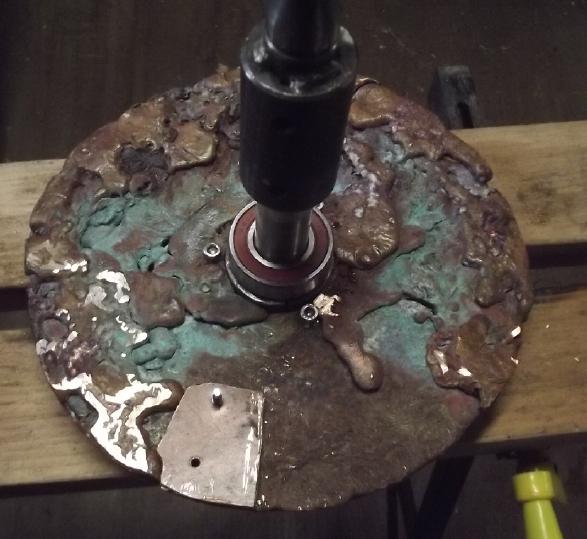 [11th] In the
evening I pulled the transmission mechanism out from
under the truck (determined not to let yet another month slip by). The
next day I replaced the magneticly pulling steel weight with a copper
one. Suddenly
realizing I could not only trim the added weight but also grind the
ugly back face of the copper disk to change the balance, I got it done
and quite well balanced in a couple of hours. Just a very few grams set
on top of the rotor will cause it to turn and dump the piece, so I
probably had it balanced to within a gram or so. That's the mass
balanced. The small
bolts holding the copper block on won't make significant magnetic
imbalance -- I trust.
[11th] In the
evening I pulled the transmission mechanism out from
under the truck (determined not to let yet another month slip by). The
next day I replaced the magneticly pulling steel weight with a copper
one. Suddenly
realizing I could not only trim the added weight but also grind the
ugly back face of the copper disk to change the balance, I got it done
and quite well balanced in a couple of hours. Just a very few grams set
on top of the rotor will cause it to turn and dump the piece, so I
probably had it balanced to within a gram or so. That's the mass
balanced. The small
bolts holding the copper block on won't make significant magnetic
imbalance -- I trust.
[13th] I put it back on. Again there was a lot of vibration and noise.
Again quite different from the previous. I think the noise was just
that I
got the copper disk too close to the magnet rotor and they were rubbing
a bit
in spots. I mounted a camera to get a video of the mechanism working.
The noise mostly quit. The vibration was different this time: as I
pressed the pedal and the truck started moving, I could see the magnet
rotor/body of the planetary vibrate around radially, as if it was
getting more torque in some rotational positions than others as the
copper
disk and
the magnet disk turned WRT each other. Magnetic torque ripple! More
like torque "breakers" than "ripples". No such phenomenon was observed
with the smooth alume alloy rotor. The poured copper rotor is nothing
like smooth, but with six magnet poles per rotation and "random"
lumpiness I thought it would all balance out. Instead I think if I
tried to drive anywhere it would surely shake until something came
loose or broke.
A good sign was that as the truck started to move, the
planetary body was largely stationary instead of turning backward.
(Well, at least averaging stationary as it shook back and
forth.) That seemed to indicate that with 1/4 inch copper instead of
alume alloy, the magnetic force balances well with
the torque
needed to move the truck. The RPM of the slip would be lower at all
points and the motor would never be turning much faster than the input
to the planetary - that "78 RPM" maximum slip I was mentioning.
 I
think I've taken the "cast a copper rotor at home" idea
about as far as it can go unless I can do it much better. I need a
piece of copper plate that will make a smooth and uniform rotor once
I've turned it true on a lathe. I think I've also eliminated the idea
of having steel pieces cog to magneticly lock the rotors together at
lower torques: the radial vibrations from that would be much worse than
from just thicker and thinner regions of copper. Oh well, 1078 RPM (78
RPM slip) at 1000 RPM of the body (city street) is 93% efficiency. At
2000 RPM (highway) it's 96%.
I
think I've taken the "cast a copper rotor at home" idea
about as far as it can go unless I can do it much better. I need a
piece of copper plate that will make a smooth and uniform rotor once
I've turned it true on a lathe. I think I've also eliminated the idea
of having steel pieces cog to magneticly lock the rotors together at
lower torques: the radial vibrations from that would be much worse than
from just thicker and thinner regions of copper. Oh well, 1078 RPM (78
RPM slip) at 1000 RPM of the body (city street) is 93% efficiency. At
2000 RPM (highway) it's 96%.
However I have all along been suspicious of buying "copper
plate". When you buy copper wire it's pure, annealed copper. And
evidently plumbing pipe
is pretty pure. Then I found "copper" pennies were 2% zinc (Can.) or 5%
(USA). (Later Wikipedia changed its mind and said Canadian pennies had
.25% zinc but 1.75% tin.) How much zinc, lead and other metals are in
"copper plate" to
make it harder and more easily machinable, and how much trapped air is
inside, all of which which might considerably detract from its
electrical
conductivity and magnetic performance? Most people buying flat plate
wouldn't care. On line I saw "deoxidized copper bar" that sounded more
promising. 8 inches wide. I figured I could buy 12 inches and silver
solder 1 inch pieces on the side to get it to 10x10 inches. I asked for
the price for 12 inches of it. There was no reply except an
auto-acknowledgment that my message had been received. Do they want to
sell stuff or not? Do they really have it?
[20th] I'm running out of steam for this
project. I've proven the
concept. Barring any unforeseen problem that might come up in actual
street/highway driving with a well built unit with good rotors,
it's a great system! (However sure something seems, true certainty only
comes from actual use.)
What next? I could just put the 5 to 1 planetary back on
with the body
clamped stationary. At least the truck would run and could go places.
No matter how I do it I'd be reluctant to drive this particular truck
over about
65 Km/Hr, which doesn't actually need the torque converter with this
motor although the RPM would getting up there at that speed, around
7000 RPM.
Or I could try something else: I could make a flat mold
for 1/2 the rotor (if I'm silver soldering to join pieces anyway) and
no doubt it would fit and Mike could melt it "in situ" in his propane
furnace. The copper chunks (pennies again? wire? pipe?) would melt into
the mold depression, then the heat would be turned off and the pool of
copper allowed to cool. After soldering the two halves together I would
do
the center mounting stuff and then turn it on Ron's lathe. (My own
lathe being just slightly too small.) That procedure at least wouldn't
need anything not available here.
Hmm... To have the mold right in the oven would need a
heavy steel box to hold the sand mixture, and I would have to try
Mike's idea of cemented sand. I suspect it would work. Or I could make
a clay mold and fire it first? I should try a
smaller sample piece first.
[21st] Well, duh! Actually, I could do both! I could put the 5 to 1
planetary back
in until such time as I have a new rotor to try out. That
wouldn't be abandoning the variable torque converter idea, diverting my
efforts to some incompatible "other" technique or making it any harder
when I got
to it, but it would be putting it off until some more propitious future
time when I have more time to make a decent copper rotor to install. In
the meantime the truck could be running.
I didn't need to change the motor-to-planetary shaft
when I changed the gearbox. They are very similar. I only had to add
the rotors. The magnet rotor stays on the 10 to 1 gearbox; the copper
one can easily be removed from the shaft.
And having made the housing with the steady bearing
holding the shaft, it shouldn't start that awful vibration that I had
mistaken to be a slight imbalance in the assembly when I first put that
gearbox on. Yet again I pulled the assembly out from under the truck
and and removed the gearbox and then the copper rotor from the shaft.
Then I dug out
the 5 to 1 gearbox. The only new thing it would need would be a
mounting to prevent the body from rotating in the housing.
 [23rd] I ground a couple of
flat faces on the 5 to 1 gearbox output
shaft to match what I had done on the 10 to
1, and mounted everything. This gear was a bit shorter (and the
output shaft 5mm shorter - grr!) so the shafts were a bit short, and I
had to have both the input and the rear drive shaft on the output not
fully "jammed in". Ug. I put in a long C-clamp across the body of the
gear since there was nothing to stop it from spinning. It was all I
could do to hold the truck stopped with the brake. It hopped over a 2
by 4 blocking the wheel with my foot still on the brake. Okay!
[23rd] I ground a couple of
flat faces on the 5 to 1 gearbox output
shaft to match what I had done on the 10 to
1, and mounted everything. This gear was a bit shorter (and the
output shaft 5mm shorter - grr!) so the shafts were a bit short, and I
had to have both the input and the rear drive shaft on the output not
fully "jammed in". Ug. I put in a long C-clamp across the body of the
gear since there was nothing to stop it from spinning. It was all I
could do to hold the truck stopped with the brake. It hopped over a 2
by 4 blocking the wheel with my foot still on the brake. Okay!
Next I found one of the pieces that I had used before to
fit the planetary body to the frame of the truck. I don't remember what
happened to the other piece and couldn't find it, but I would have to
change it anyway. I found a bar of alume to make a new piece from.
[24th] I tried the truck out again this time I pressed on the pedal a
couple of times. When I did that, it bent the C-clamp and flung it
away. (Did I say alume for a mounting piece? Nah, too soft! I need a
good chunk of steel.)
After that, I'll definitely need to find why the
programmer won't connect to the motor controller, and then change a few
things. (I suspect Miles deliberately cut a wire to keep anyone from
altering the settings.)
[29th] I looked for a piece of steel, and in the scraps turned up the
original piece, all carefully cut and shaped! If I weld it to the other
piece (or drill new bolt holes to adjust the position) it'll probably
work fine. Yay!
At least the truck will be
running again, soon rather than
later!
Other
"Green"
& Electric Equipment
Projects
Cabin Construction
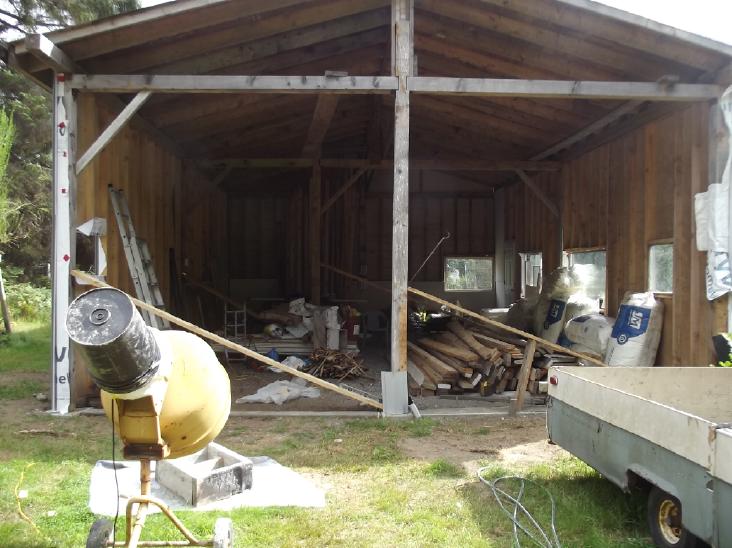 The far end,
already walled, was pretty plumb, and it was straight front to back,
but the middle and open end posts were leaning a bit to the south
(here to the right). I pressed in some 2 by 6es at angles to push them
straighter.
(The bottoms have pins to the footings, so they wouldn't budge.) But it
was a bit problematic since the roof would have to twist for just one
end to
move, so I compromised with "a little straighter", not pressing things
too far, and put the diagonal
braces back on with the adjustment, then did one of the outer wall
sections.
The far end,
already walled, was pretty plumb, and it was straight front to back,
but the middle and open end posts were leaning a bit to the south
(here to the right). I pressed in some 2 by 6es at angles to push them
straighter.
(The bottoms have pins to the footings, so they wouldn't budge.) But it
was a bit problematic since the roof would have to twist for just one
end to
move, so I compromised with "a little straighter", not pressing things
too far, and put the diagonal
braces back on with the adjustment, then did one of the outer wall
sections.
 After I got
most of the studs in I realized I could quickly put in two full and one
already cut half sheet of plywood. Then I would feel better about
removing the diagonal brace. I finished the window frame part and above
it later.
After I got
most of the studs in I realized I could quickly put in two full and one
already cut half sheet of plywood. Then I would feel better about
removing the diagonal brace. I finished the window frame part and above
it later.
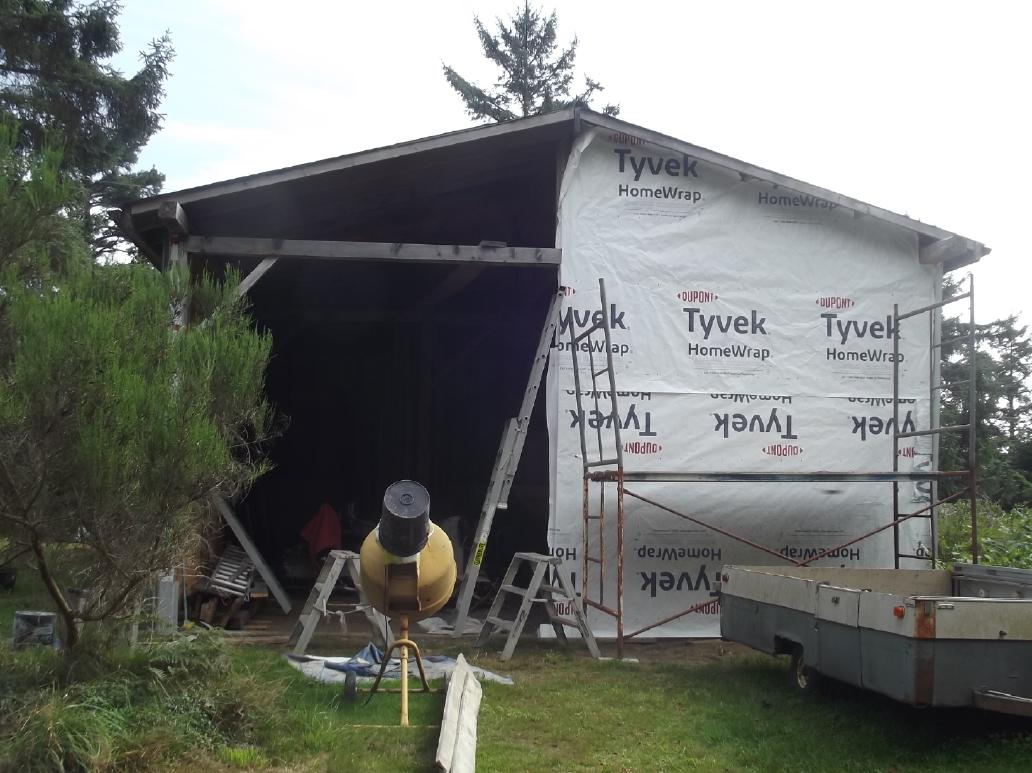 Soon I had finished the
framing and plywood and the next day I was stapling up tyvek in the
rain to keep it dry.
Soon I had finished the
framing and plywood and the next day I was stapling up tyvek in the
rain to keep it dry.
I bought some scaffolding from someone who was moving. I
still had to use the ladder on the single-level scaffold to reach the
high area.
There was a penalty: the sharp "clack" of the staple gun
brought back my "tennis elbow" or "tendinitis" with a vengeance. Of
course I only noticed it afterward, not while I was doing it. I wished
I had just let the wall soak! OTOH it did have to be done. (Maybe if I
had just done 5 staples or so a day? Haha - it would have ripped off
and blown away before it was up.)
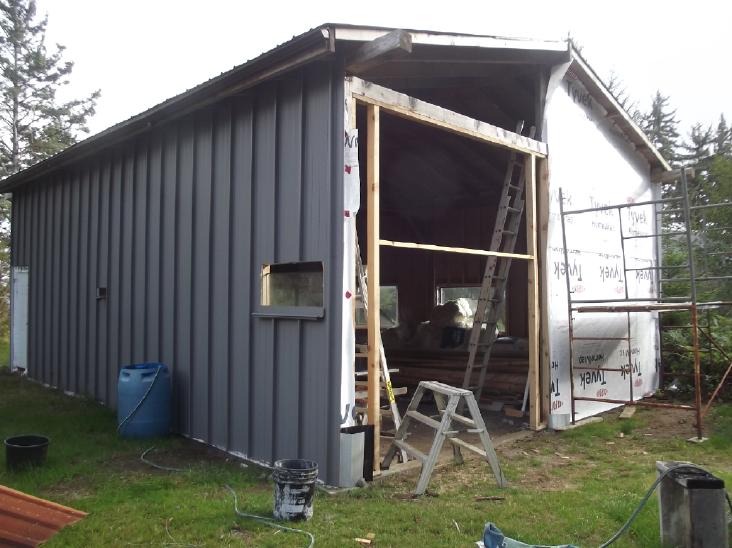 Finally I got
to the last wall section. I decided to put a roll-up garage door in it
with the floor level with the ground (concreted over at some point),
and to have a room above it. That would be the only spot with a second
floor. I made the opening for a 7 by 9 foot door.
Finally I got
to the last wall section. I decided to put a roll-up garage door in it
with the floor level with the ground (concreted over at some point),
and to have a room above it. That would be the only spot with a second
floor. I made the opening for a 7 by 9 foot door.
 I put the
short studs above the doorway. Then found that they lined up badly for
plywood - a 4-1/4 foot area and a 7-3/4 foot one, requiring three
sheets of cut-up plywood instead of two whole ones, 4 and 8 feet.
I put the
short studs above the doorway. Then found that they lined up badly for
plywood - a 4-1/4 foot area and a 7-3/4 foot one, requiring three
sheets of cut-up plywood instead of two whole ones, 4 and 8 feet.
So I unscrewed them all and redid it. The 4-foot could be
a vertical sheet extending up to the rafters. But I didn't get any
plywood up. It started pouring rain, a real deluge. Then other things
intervened.
Thinking "out loud" here.
There is a lot conspiring to make the second floor's floor as high as
possible, leaving very minimal headroom up there. Over most of the area
will be the wooden floor, 2 by 6s resting on 4 inch tall blocks and
that high up the outer walls. That's a foot gone. With just 7 foot
height on the lower floor, the ceiling is thus at the 8 foot mark. In
the garage section there's no raised floor, but roll-up doors needs 8
feet headroom for the track, making it the same.
Then the second floor joists need to be at least 2 by 6s,
so that's about 8 feet 8 inches. The top is 16 feet, so 15 feet 4
inches to the 2 by 8 rafters. That's only about 6 feet 8 inches at the
peak - and that drops down to about 5 feet 2 inches by the middle and 3
feet 7 inches by the outside wall. I would only be able to stand up
straight near the peak of the roof.
Looking at my present roll-up doors, I might manage to
shave about an inch or two off that 8 feet. Every inch counts! And the
tracks only go 7 feet along the ceiling. If I used (say) 7 foot long 3
by 3s for floor joists above the tracks (garage ceiling can be lower
elsewhere with 2 by 6s), 2 + 3 is 5 inches lower, leaving 7 feet 1 inch
height at the peak and 4 feet at the outside wall. still horribly
short. Hmm, what else can I do...?
That leaves the top gable end area to frame. The second floor
room needed a window. I had found a
double-glass one that looked suitable at the refuse station, in a large
frame (with the other pane missing) that I would take it out of. I
would love to leave it until the second floor is in, saving a lot of
being on ladders, but the outer walls should doubtless be done first.
[Later] My present thought is to cut about 11 inches off the bottom
door section and the tracks and reduce the opening to 6 feet 1 inch or
so. I hope
that's not too hard to do, but I don't have the door yet. That will add
the badly needed 11 inches headroom upstairs. I guess I'll have to put
another top frame for the door 11 inches under the one I've just made
twice!
I may also use 4 by 4 floor joists upstairs instead of 2
by 6s to gain another 2 inches of headroom. By that point perhaps a
narrow closet along the outer wall would leave full standing headroom
in the room itself - at least for me.
Now not only is the weather getting cold and wet, there
are a bunch of things that should wait until I have the door to see how
low I can fit it in and thus where the upstairs floor should sit.
Perhaps I should start on the NE corner of the downstairs floor and use
up some 2 by 6s from that big pile?
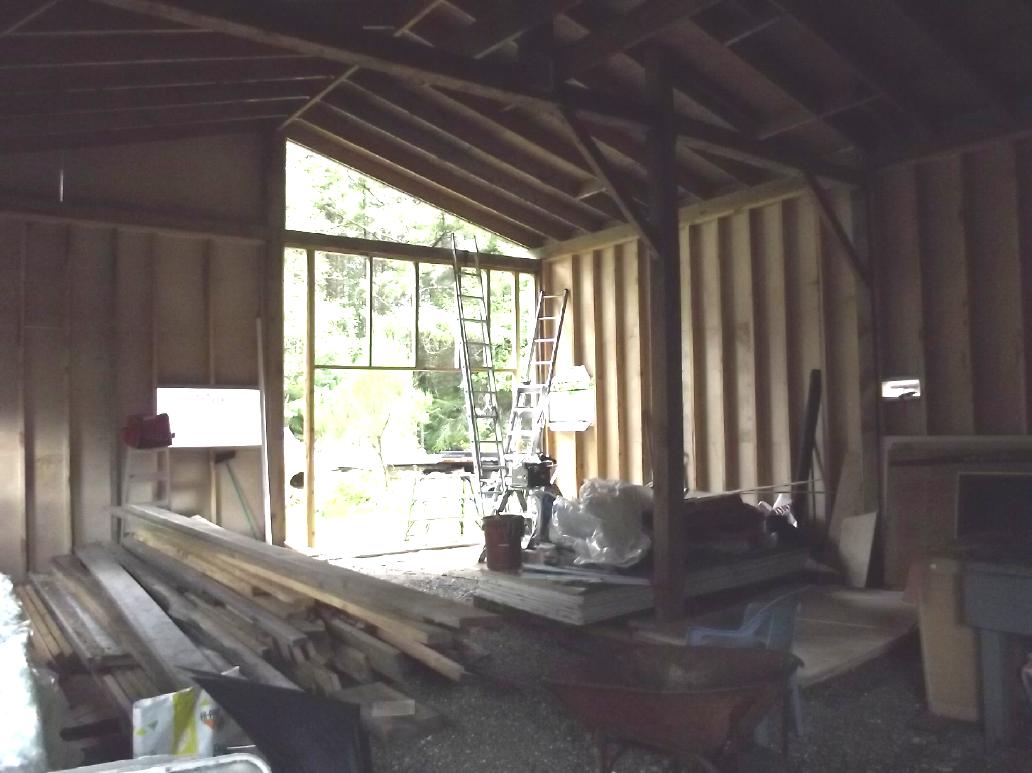 A view from the inside. Of course all this clutter - lumber,
insulation, gyproc, tools & supplies - will eventually be replaced
by other clutter. Er, I mean, will be gone.
A view from the inside. Of course all this clutter - lumber,
insulation, gyproc, tools & supplies - will eventually be replaced
by other clutter. Er, I mean, will be gone.
I had decided R3 per inch
lawn grass wasn't good enough and I lavishly used up most of the bags I
collected last year for garden mulch and chicken bedding. I had decided
to use R4 per inch cellulose fiber instead. It was on the web sites at
Home Depot and Home Hardware. Now I find I can't buy it! Period.
Seemingly no one in all Northern BC wants to sell it unless you order
an entire truck load! What?!? It's much cheaper and better than (R3.6
per inch) fiberglass, and environmentally benign. Even if it doesn't
come in batts you'd think it would be very popular for attic fill,
where everyone wants really, really thick insulation and it's much the
most affordable. Perhaps too many people think it's too flammable, when
in a wall it's actually less (because it keeps air out of the stud
space). And how many of the same people don't hesitate to use more
flammable styrene foam insulation?
Apparently I shouldn't have wasted all those bags of grass
after all! Now I can't get more until next summer. I may be unwillingly
forced to buy uggy, itchy fiberglass after all.
September's
Gardening
My corn plants never grew much. My squash plants grew
painfully slowly over the summer, and while they spread out in August,
one well over ten feet, there were no squashes, even little ones, in
September. Just one squash started early enough, but it rotted and fell
off without growing much, and after that the flowers just bloomed and
then fell off.
It seems they both need the most favored locations to grow
around here. Corn seems to need to be under cover - cold frame or
whatever - until it is knee high and the weather warmer, then
with the cover removed to
get enough sunlight.
These weren't the only disappointments over the summer. A
squirrel nipped all of the very few just-started pears off the pear
trees. (zero pears in six years so far!) There were just 10 little
scabby apples between three trees. A deer crashed a feeble wire fence
and ate a bunch of leaves and the three best apples. The potato patch
in an unfenced garden kept getting trimmed down by the deer and
produced few and small potatos. (I was hoping the deer knew potato tops
are poisonous!) By the time the tops died down it was just a field of
grass again. I planted three rows of carrots but romaine lettuce came
up. (from last year's saved seed. I either mislabeled the bag or used
the wrong one. Why didn't I recognize them?) I sold some lettuce at the
Tlell farmers market, but by the
time I planted carrots they were pretty small by fall, barely worth
saving. The garlic was good, but my onions didn't grow well. In
September a deer managed to get under the wire fence around the main
garden and eat the leaves off the beans, the hazelnut bush and a bunch
of other things. Sneaky critters - I didn't think they could squeeze
under tight spaces! I had raised the fence wire off the ground a bit so
I could trim under it with the weedeater or rototiller and so it
wouldn't rust - which also made it that bit higher and harder to jump
over - but of course it was uneven and there were a couple of notably
high gaps underneath. I could see where the deer bent the bottom of the
wire up to get under. I put in some wooden stakes there.
There were successes too. The lettuce grew great. Lots of
blueberries and some black currents. Huge Rhubarb stems and Lots of
potatos - in fact, I sold some at the Tlell farmers Market. (They
pretty much paid for my lunches there.) Good cabbages, beans, peas. The
strawberries and one of the raspberry varieties made a second crop into
September and even October. The green grape vine in the greenhouse grew
its first small cluster of purple grapes. (Huh?) I had some good
asparagus from the patch in the greenhouse (4 years now?) and I left
enough to grow that I was trimming it with the hedge clippers so I
could get by it. It grows up to the roof then the stalks die off in the
winter.
The Tlell market ended October 1st - just when my tomatos
were getting ready. I don't want to go to the bigger market in town
with just a few items. (Now what do I do with them all? I'm not really
a canner.)
A stalk of
millet, mid
September. Not ripening until October - must need a really sunny spot.
 A couple of
volunteer millet plants came up (millet seeds
are in bird seed that I feed the chickens) and ripened, one in the
garden and one near it. There was one a couple of years ago, too. At
first I thought it was corn, then I let it
continue to grow out of curiosity. I may plant millet instead of corn
next
year. or maybe in addition. It is said that deer don't eat millet, so
conceivably I could plant it in the unfenced garden plot, maybe instead
of potatos? It sounds too good to be true, but so far they haven't
touched the one outside the garden, and it's about ripe. (OTOH it
started ripening quite late - will I really get a crop?)
A couple of
volunteer millet plants came up (millet seeds
are in bird seed that I feed the chickens) and ripened, one in the
garden and one near it. There was one a couple of years ago, too. At
first I thought it was corn, then I let it
continue to grow out of curiosity. I may plant millet instead of corn
next
year. or maybe in addition. It is said that deer don't eat millet, so
conceivably I could plant it in the unfenced garden plot, maybe instead
of potatos? It sounds too good to be true, but so far they haven't
touched the one outside the garden, and it's about ripe. (OTOH it
started ripening quite late - will I really get a crop?)
 Three sunflowers planted in mid April that then survived the slugs when
transplanted out made good heads by the start of September.
Three sunflowers planted in mid April that then survived the slugs when
transplanted out made good heads by the start of September.
I may try out the oil press I bought a while back and see
how much sunflower oil comes from a head.
 The nine+ foot
sunflower and some others planted and put out a couple of weeks later
did grow seeds, okay but with the shells still whitish by the time I
picked them in late September. Obviously they need to be started as
early as possible to ensure a good, ripe crop.
The nine+ foot
sunflower and some others planted and put out a couple of weeks later
did grow seeds, okay but with the shells still whitish by the time I
picked them in late September. Obviously they need to be started as
early as possible to ensure a good, ripe crop.
 The sunflowers that got started a couple of weeks later yet finally
started making smaller
flowers, but by then there seemed to be no pollinating insects around.
Finally
on the 12th it was a little warmer and suddenly hover flies and a few
other flies were all over them. If they matured, at least the shells
wouldn't be empty. But would they? The solar chart (Electricity
Generation) shows how much less sun
there has been this month compared to August (and even compared to last
September).
The sunflowers that got started a couple of weeks later yet finally
started making smaller
flowers, but by then there seemed to be no pollinating insects around.
Finally
on the 12th it was a little warmer and suddenly hover flies and a few
other flies were all over them. If they matured, at least the shells
wouldn't be empty. But would they? The solar chart (Electricity
Generation) shows how much less sun
there has been this month compared to August (and even compared to last
September).
I got a couple of small heads, but I'm not sure they were from the very
last planted few.
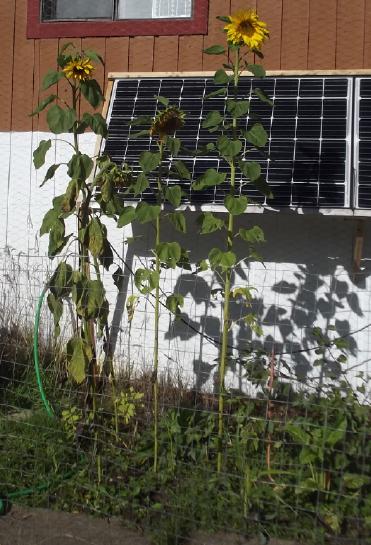 The ones set out last -
Early June, was it? - grew tall but were purely ornamental. The one
planted in the main garden also didn't mature - not quite as warm and
sunny there as by the house.
The ones set out last -
Early June, was it? - grew tall but were purely ornamental. The one
planted in the main garden also didn't mature - not quite as warm and
sunny there as by the house.
Electricity
Storage
(No Reports)
Electricity
Generation
My Solar Power System
The Usual Daily/Monthly/Yearly Log of Solar
Power Generated [and grid power consumed]
(All times are in PST: clock 48 minutes ahead of local sun time, not
PDT which
is an hour and 48 minutes ahead. (DC) battery system power output
readings are reset to zero
daily (often just for LED lights, occasionally used with other loads:
Chevy Sprint electric car, inverters in power outages or other 36V
loads), while the
grid tied readings are cumulative.)
Daily Figures
Notes: House Main
meter (6 digits) accumulates. DC meter now
accumulates until [before] it loses precision (9.999 WH => 0010
KWH), then is
reset. House East and Cabin meters (4
digits) are reset to 0 when they get near 99.99 (which goes to "100.0")
- owing to loss of second decimal precision.
Km = Nissan Leaf electric car drove distance, then car was charged.
New Order of Daily Solar Readings (Beginning May 2022):
Date House, House, House, Cabin => Total KWH Solar [Notable
power
Uses (EV); Grid power meter@time] Sky/weather
Main
DC (Carport)
August
31st 591.46, 4.87, 55.13, 65.07 => 19.37 [9014@20:00] Mostly sunny,
warm. (Cool when not sunny)
September
1st 596.26, 4.94, 58.85, 68.05 => 11.57 [140Km; 9038@20:00]
2d 601.67, 4.97, 62.87, 71.32 => 12.73 [55Km; 9052@20:00] A
few sunny periods
3rd 606.44, 5.04, 66.61, 74.38 => 11.64 [35Km; 9060@19:00]
4th 608.96, 5.06, 68.24, 76.01 => 5.80 [9068@20:00]
Clouds, bit o' rain late PM
5th 614.57, 5.15, 72.16, 78.80 => 12.41 [9078@19:30] Cabin (solar)
was unplugged a couple of hours when I mowed the lawn. (Not hit cord!)
6th 618.69, 5.20, 75.05, 81.50 => 9.76 [55Km;
9095@20:00] Electric heat in the bedroom is using grid power! (it gets
worse as it gets colder)
7th 623.34, 5.25, 78.41, 84.57 => 11.13 [9103@20:00] Finished 2nd
last wall plywood. Getting dark in there! (Last section gets garage
door.)
8th 627.32, 5.28, 81.23, 86.90 => 9.16 [97Km; 9124@20:00]
9th 633.32, 5.31, 86.18, 90.17 => 14.25 [110Km, 9149@23:00]
10th 635.83, 5.39, 87.78, 91.35 => 5.37 [35Km;
9171@19:30]
11th 638.71, 5.47, 89.67, 93. 26 => 6.76 [9188@19:30]
12th 643.42, 5.55, 93.02, 96.14 => 11.02 [9197@19:30]
13rd 647.23, 5.58, 95.84, 2.53 => 10.19 [9207@19:30]
14th 651.30, 6.04, 3.44, 5.34 => 10.40
[9219@19:00]
15th 657.35, 6.11, 8.35, 9.19 => 14.94
[9230@19:30] Some sun today! Warm while it was out.
16th 659.93, 6.16, 10.34, 10.70 => 6.13 [9239@19:00] Fall
seems to have fallen. Pretty cool out now - will garden grow any more?
17th 664.17, 6.22, 13.05, 13.15 => 9.46 [9252@19:00] Bit
o' sun, later rain.
18th 667.44, 6.25, 15.43, 15.26 => 7.79 [55Km; 9275@22:30]
19th 672.58, 6.31, 19.51, 18.25 => 12.27 [10Km; 9283@19:30]
20th 679.47, 6.34, 24.77, 23.00 => 16.93 [55Km; 9294@19:00] Gosh,
sun! Tan!
21st 682.95, 6.41, 27.19, 25.27 => 8.24 [9312@19:00] Pretty
warm!
22d 684.39, 6.49, 28.11, 26.15 => 3.32 [90Km;
9336@19:00]
23rd 688.91, 6.57, 32.24, 29.55 => 12.13 [55Km; 9360@20:00; 50Km]
24th 690.79, 6.64, 33.57, 30.63 => 4.36 [35Km;
9385@19:00]
25th 694.66, 6.75, 36.79, 33.15 => 9.72 [9402@19:00]
26th 698.06, 6.88, 39.19, 35.24 => 8.02 [9416@19:00]
27th 700.14, 6.96, 40.38, 36.46 => 4.57 [55Km;
9433@19:00]
28th 706.90, 7.04, 45.42, 39.31 => 14.65 [30Km; 9451@19:30] Sunny
day! Breaker was blown to cabin owing to running a cord to travel
trailer, hence lower collection at cabin. (Dang shoulda made ~16KWH!)
29th 712.77, 7.09, 49.99, 43.22 => 14.40 [85Km; 9488@19:00] Sunny
again!
30th 715.79, 7.20, 52.05, 45.16 => 7.13 [50Km;
9515@19:00]
October
1st 718.37, 7.27, 53.95, 46.65 => 6.04 [75Km; 9566@19:00]
2d 722.02, 7.37, 56.38, 48.76 => 8.29 [60 Km; 9604@21:30]
3rd 725.02, 7.45, 58.52, 50.51 => 6.37 [9626@19:00]
4th 726.53, 7.52, 59.06, 51.31 => 2.92 [9676@20:00] --
I think there's something funny with the carport system.
5th 730.20, 7.55, 60.63, 53.27 => 7.23 [45Km; 9716@18:30]
6th 731.64, 7.58, 61.11, 54.06 => 2.64 [55Km; 9754@22:00]
7th 735.36, 7.62, 62.58, 56.01 => 7.18 [45Km; 9784@18:00]
8th 735.78, 7.65, 62.72, 56.30 => 0.88 [75Km; 9817@18:30] WOW!
Chart of daily KWH from solar panels.
(Compare September 2023
(left) with August 2023 & with September 2022.)
Days of
__ KWH
|
September 2023
(18 collectors)
|
August 2023
(18 collectors)
|
September 2022
(18 collectors)
|
0.xx
|
|
|
|
1.xx
|
|
|
1 (power outage)
|
2.xx
|
|
|
|
3.xx
|
1
|
|
|
4.xx
|
2
|
1
|
1
|
5.xx
|
2
|
1
|
1
|
6.xx
|
2
|
|
1
|
7.xx
|
2
|
1
|
3
|
8.xx
|
2
|
1
|
|
9.xx
|
3
|
1
|
2
|
10.xx
|
2
|
1
|
3
|
11.xx
|
4
|
2
|
1
|
12.xx
|
3
|
|
4
|
13.xx
|
1
|
3
|
1
|
14.xx
|
4
|
2
|
|
15.xx
|
|
|
|
16.xx
|
1
|
1
|
|
17.xx
|
|
1
|
1
|
18.xx
|
|
3
|
3
|
19.xx
|
|
2
|
2
|
20.xx
|
|
3
|
2
|
21.xx
|
|
|
2
|
22.xx
|
|
5
|
2
|
23.xx
|
|
2
|
|
24.xx
|
|
|
|
25.xx
|
|
|
|
26.xx
|
|
|
|
27.xx
|
|
1
|
|
Total KWH
for month
|
295.65
|
518.00
|
406.2
|
Km Driven
on Electricity
|
1115.1 Km
(150 KWH?) |
995.5 Km
(130 KWH?) |
1190 Km
(~165 KWH?) |
Things Noted - September 2023
* As the chart shows, last September (2022) was a lot nicer than this
year's. Storms, clouds, not one whole sunny day.
Monthly Summaries: Solar Generated KWH [& Power used from
grid KWH]
As these tables are getting long, I'm not repeating the log of monthly
reports. The reports for the first four full years (March 2019 to
February 2023) may be found in TE
News
#177,
February
2023.
2023 - (House roof, lawn + DC + Cabin + Carport, Pole) Solar
Jan KWH: 40.57 + 3.06 + 28.31 + 21.85 = 93.79 Solar [grid: 1163; car
(these are very rough estimates): 130]
Feb KWH: 59.19 + 2.70 + 38.10 + 32.47 = 132.46 Solar [grid: 1079; car:
110]
(Four years of solar!)
Mar KWH: 149.49 + 2.72 + 53.85 + 92.08 = 298.14 Solar
[grid: 981; car:
140]
Apr KWH: 176.57 + 2.71 + 121.21 + 108.34 = 408.83 [grid: 676; car:
160] -- The three "Lawn"
collectors
moved to South "Wall"
May KWH:266.04 + 2.04 + 194.13 + 180.31 = 642.52 [grid: 500; car: 175]
Jun KWH: 237.55 + 3.70 + 172.56 + 126.31 = 540.12 [grid: 464; car: 190]
July KWH:236.99 + 1.95 + 169.16 + 155.21 = 563.31 [grid: 343; car: 180]
Aug KWH:223.61 + 1.78 + 158.31 + 134.40 = 518.00 [grid: 305; car: 130]
Sep KWH:124.33 + 2.33 + 92.76 + 76.23 = 295.65 [grid:
501; car: 150]
Annual Totals
1. March 2019-Feb. 2020: 2196.15 KWH Solar [used 7927 KWH
from grid]
2. March 2020-Feb. 2021: 2069.82 KWH Solar [used 11294 KWH from grid]
(More electric heat - BR, Trailer & Perry's RV)
3. March 2021-Feb. 2022: 2063.05 KWH Solar [used 10977 KWH from grid]
4a. March 2022-August 2022: in (the best) 6 months, about 2725 KWH
solar - more than in any previous entire year!
4. March2022-Feb. 2023: 3793.37 KWH Solar [used 12038 KWH from grid]
Money Saved or Earned - @ 12¢ [All BC residential elec.
rate] ; @
50¢ [2018 cost of diesel fuel to BC Hydro] ; @ 1$ per KWH [actual
total
cost to BC Hydro
in 2022 according to an employee]:
1. 263.42$ ; 1097.58$ ; 2196.15$
2. 248.38$ ; 1034.91$ ; 2069.82$
3. 247.57$ ; 1031.53$ ; 2063.05$
4. 455.20$ ; 1896.69$ ; 3793.37$
It can be seen that the benefit to the society as a whole
on Haida Gwaii from solar power installations is much greater than the
cost savings to the individual user of electricity, thanks to the heavy
subsidization of our power
owing to the BC government policy of having the same power rate across
the entire province regardless of the cost of production. And it can be
insurance: With some
extra equipment and a battery, sufficient solar can deliver essential
power in
electrical outages however long. (Feb 28th 2023: And it's probably well
over 1$/KWH by now the way inflation of diesel fuel and other costs is
running.)
http://www.TurquoiseEnergy.com
Haida Gwaii, BC Canada


 On the 27th I finished framing the last main wall section with
a 7 by 9 foot opening for a roll-up garage door. I spaced four 2 by 4s
over the door frame to get relatively even spacings. But
they were badly mismatched for sheeting with 4 by 8 foot plywood, so I
took them off
and redid them. Then a
deluge of rain stopped me from putting up plywood. It turned out that
was just as well.
On the 27th I finished framing the last main wall section with
a 7 by 9 foot opening for a roll-up garage door. I spaced four 2 by 4s
over the door frame to get relatively even spacings. But
they were badly mismatched for sheeting with 4 by 8 foot plywood, so I
took them off
and redid them. Then a
deluge of rain stopped me from putting up plywood. It turned out that
was just as well. I
replaced the magneticly troublesome steel weight with a copper one. But
when I put it back on, again there was a lot of vibration. I mounted a
camera to get a video of the mechanism working.
The vibration was different this time: as I
pressed the pedal and the truck started moving, I could see the magnet
rotor/body of the planetary vibrate around radially, as if it was
getting more torque some rotations than others as the copper disk and
the magnet disk turned WRT each other. Magnetic torque ripple! But more
like torque "breakers" than "ripples". No such phenomenon was observed
with the smooth alume alloy rotor. The poured copper rotor is nothing
like smooth, but with six magnet poles per rotation and "random"
lumpiness I thought it would all balance out. Instead I think if I
tried to drive anywhere it would surely shake until something came
loose or broke.
I
replaced the magneticly troublesome steel weight with a copper one. But
when I put it back on, again there was a lot of vibration. I mounted a
camera to get a video of the mechanism working.
The vibration was different this time: as I
pressed the pedal and the truck started moving, I could see the magnet
rotor/body of the planetary vibrate around radially, as if it was
getting more torque some rotations than others as the copper disk and
the magnet disk turned WRT each other. Magnetic torque ripple! But more
like torque "breakers" than "ripples". No such phenomenon was observed
with the smooth alume alloy rotor. The poured copper rotor is nothing
like smooth, but with six magnet poles per rotation and "random"
lumpiness I thought it would all balance out. Instead I think if I
tried to drive anywhere it would surely shake until something came
loose or broke. [23rd] I put the drive
shaft with gearbox together and into the truck, and put in a long
C-clamp across the body of the
gear since there was nothing to stop it from spinning. It was all I
could do to hold the "idling" truck stopped with the brake. It hopped
over a 2
by 4 blocking the wheel even with my foot still on the brake. Okay!
When I
pressed on the pedal it bent the C-clamp and pushed it
away.
[23rd] I put the drive
shaft with gearbox together and into the truck, and put in a long
C-clamp across the body of the
gear since there was nothing to stop it from spinning. It was all I
could do to hold the "idling" truck stopped with the brake. It hopped
over a 2
by 4 blocking the wheel even with my foot still on the brake. Okay!
When I
pressed on the pedal it bent the C-clamp and pushed it
away. My 2015 Leaf
EV now has 100 megameters on it. In the
summer
weather and as the Bridgestone Ecopia
'low
rolling resistance' tires have 'worn in', the car has definitely been
using less
energy per kilometer. On my most frequent trip, driving to town and
back almost 55Km, with the old tires the
most the car ever had was "58%" battery charge left - usually "52" to
"54" in
summer, more often well down into the "40%"s in winter. Now sometimes
it has been
even over "60%",
notwithstanding that the "battery health" on the 8 year old car is down
from "12 bars" to "11 bars".
My 2015 Leaf
EV now has 100 megameters on it. In the
summer
weather and as the Bridgestone Ecopia
'low
rolling resistance' tires have 'worn in', the car has definitely been
using less
energy per kilometer. On my most frequent trip, driving to town and
back almost 55Km, with the old tires the
most the car ever had was "58%" battery charge left - usually "52" to
"54" in
summer, more often well down into the "40%"s in winter. Now sometimes
it has been
even over "60%",
notwithstanding that the "battery health" on the 8 year old car is down
from "12 bars" to "11 bars".



 [11th] In the
evening I pulled the transmission mechanism out from
under the truck (determined not to let yet another month slip by). The
next day I replaced the magneticly pulling steel weight with a copper
one. Suddenly
realizing I could not only trim the added weight but also grind the
ugly back face of the copper disk to change the balance, I got it done
and quite well balanced in a couple of hours. Just a very few grams set
on top of the rotor will cause it to turn and dump the piece, so I
probably had it balanced to within a gram or so. That's the mass
balanced. The small
bolts holding the copper block on won't make significant magnetic
imbalance -- I trust.
[11th] In the
evening I pulled the transmission mechanism out from
under the truck (determined not to let yet another month slip by). The
next day I replaced the magneticly pulling steel weight with a copper
one. Suddenly
realizing I could not only trim the added weight but also grind the
ugly back face of the copper disk to change the balance, I got it done
and quite well balanced in a couple of hours. Just a very few grams set
on top of the rotor will cause it to turn and dump the piece, so I
probably had it balanced to within a gram or so. That's the mass
balanced. The small
bolts holding the copper block on won't make significant magnetic
imbalance -- I trust. I
think I've taken the "cast a copper rotor at home" idea
about as far as it can go unless I can do it much better. I need a
piece of copper plate that will make a smooth and uniform rotor once
I've turned it true on a lathe. I think I've also eliminated the idea
of having steel pieces cog to magneticly lock the rotors together at
lower torques: the radial vibrations from that would be much worse than
from just thicker and thinner regions of copper. Oh well, 1078 RPM (78
RPM slip) at 1000 RPM of the body (city street) is 93% efficiency. At
2000 RPM (highway) it's 96%.
I
think I've taken the "cast a copper rotor at home" idea
about as far as it can go unless I can do it much better. I need a
piece of copper plate that will make a smooth and uniform rotor once
I've turned it true on a lathe. I think I've also eliminated the idea
of having steel pieces cog to magneticly lock the rotors together at
lower torques: the radial vibrations from that would be much worse than
from just thicker and thinner regions of copper. Oh well, 1078 RPM (78
RPM slip) at 1000 RPM of the body (city street) is 93% efficiency. At
2000 RPM (highway) it's 96%. [23rd] I ground a couple of
flat faces on the 5 to 1 gearbox output
shaft to match what I had done on the 10 to
1, and mounted everything. This gear was a bit shorter (and the
output shaft 5mm shorter - grr!) so the shafts were a bit short, and I
had to have both the input and the rear drive shaft on the output not
fully "jammed in". Ug. I put in a long C-clamp across the body of the
gear since there was nothing to stop it from spinning. It was all I
could do to hold the truck stopped with the brake. It hopped over a 2
by 4 blocking the wheel with my foot still on the brake. Okay!
[23rd] I ground a couple of
flat faces on the 5 to 1 gearbox output
shaft to match what I had done on the 10 to
1, and mounted everything. This gear was a bit shorter (and the
output shaft 5mm shorter - grr!) so the shafts were a bit short, and I
had to have both the input and the rear drive shaft on the output not
fully "jammed in". Ug. I put in a long C-clamp across the body of the
gear since there was nothing to stop it from spinning. It was all I
could do to hold the truck stopped with the brake. It hopped over a 2
by 4 blocking the wheel with my foot still on the brake. Okay! The far end,
already walled, was pretty plumb, and it was straight front to back,
but the middle and open end posts were leaning a bit to the south
(here to the right). I pressed in some 2 by 6es at angles to push them
straighter.
(The bottoms have pins to the footings, so they wouldn't budge.) But it
was a bit problematic since the roof would have to twist for just one
end to
move, so I compromised with "a little straighter", not pressing things
too far, and put the diagonal
braces back on with the adjustment, then did one of the outer wall
sections.
The far end,
already walled, was pretty plumb, and it was straight front to back,
but the middle and open end posts were leaning a bit to the south
(here to the right). I pressed in some 2 by 6es at angles to push them
straighter.
(The bottoms have pins to the footings, so they wouldn't budge.) But it
was a bit problematic since the roof would have to twist for just one
end to
move, so I compromised with "a little straighter", not pressing things
too far, and put the diagonal
braces back on with the adjustment, then did one of the outer wall
sections. After I got
most of the studs in I realized I could quickly put in two full and one
already cut half sheet of plywood. Then I would feel better about
removing the diagonal brace. I finished the window frame part and above
it later.
After I got
most of the studs in I realized I could quickly put in two full and one
already cut half sheet of plywood. Then I would feel better about
removing the diagonal brace. I finished the window frame part and above
it later. Soon I had finished the
framing and plywood and the next day I was stapling up tyvek in the
rain to keep it dry.
Soon I had finished the
framing and plywood and the next day I was stapling up tyvek in the
rain to keep it dry. Finally I got
to the last wall section. I decided to put a roll-up garage door in it
with the floor level with the ground (concreted over at some point),
and to have a room above it. That would be the only spot with a second
floor. I made the opening for a 7 by 9 foot door.
Finally I got
to the last wall section. I decided to put a roll-up garage door in it
with the floor level with the ground (concreted over at some point),
and to have a room above it. That would be the only spot with a second
floor. I made the opening for a 7 by 9 foot door. I put the
short studs above the doorway. Then found that they lined up badly for
plywood - a 4-1/4 foot area and a 7-3/4 foot one, requiring three
sheets of cut-up plywood instead of two whole ones, 4 and 8 feet.
I put the
short studs above the doorway. Then found that they lined up badly for
plywood - a 4-1/4 foot area and a 7-3/4 foot one, requiring three
sheets of cut-up plywood instead of two whole ones, 4 and 8 feet. A view from the inside. Of course all this clutter - lumber,
insulation, gyproc, tools & supplies - will eventually be replaced
by other clutter. Er, I mean, will be gone.
A view from the inside. Of course all this clutter - lumber,
insulation, gyproc, tools & supplies - will eventually be replaced
by other clutter. Er, I mean, will be gone. A couple of
volunteer millet plants came up (millet seeds
are in bird seed that I feed the chickens) and ripened, one in the
garden and one near it. There was one a couple of years ago, too. At
first I thought it was corn, then I let it
continue to grow out of curiosity. I may plant millet instead of corn
next
year. or maybe in addition. It is said that deer don't eat millet, so
conceivably I could plant it in the unfenced garden plot, maybe instead
of potatos? It sounds too good to be true, but so far they haven't
touched the one outside the garden, and it's about ripe. (OTOH it
started ripening quite late - will I really get a crop?)
A couple of
volunteer millet plants came up (millet seeds
are in bird seed that I feed the chickens) and ripened, one in the
garden and one near it. There was one a couple of years ago, too. At
first I thought it was corn, then I let it
continue to grow out of curiosity. I may plant millet instead of corn
next
year. or maybe in addition. It is said that deer don't eat millet, so
conceivably I could plant it in the unfenced garden plot, maybe instead
of potatos? It sounds too good to be true, but so far they haven't
touched the one outside the garden, and it's about ripe. (OTOH it
started ripening quite late - will I really get a crop?) Three sunflowers planted in mid April that then survived the slugs when
transplanted out made good heads by the start of September.
Three sunflowers planted in mid April that then survived the slugs when
transplanted out made good heads by the start of September. The nine+ foot
sunflower and some others planted and put out a couple of weeks later
did grow seeds, okay but with the shells still whitish by the time I
picked them in late September. Obviously they need to be started as
early as possible to ensure a good, ripe crop.
The nine+ foot
sunflower and some others planted and put out a couple of weeks later
did grow seeds, okay but with the shells still whitish by the time I
picked them in late September. Obviously they need to be started as
early as possible to ensure a good, ripe crop. The sunflowers that got started a couple of weeks later yet finally
started making smaller
flowers, but by then there seemed to be no pollinating insects around.
Finally
on the 12th it was a little warmer and suddenly hover flies and a few
other flies were all over them. If they matured, at least the shells
wouldn't be empty. But would they? The solar chart (Electricity
Generation) shows how much less sun
there has been this month compared to August (and even compared to last
September).
The sunflowers that got started a couple of weeks later yet finally
started making smaller
flowers, but by then there seemed to be no pollinating insects around.
Finally
on the 12th it was a little warmer and suddenly hover flies and a few
other flies were all over them. If they matured, at least the shells
wouldn't be empty. But would they? The solar chart (Electricity
Generation) shows how much less sun
there has been this month compared to August (and even compared to last
September). The ones set out last -
Early June, was it? - grew tall but were purely ornamental. The one
planted in the main garden also didn't mature - not quite as warm and
sunny there as by the house.
The ones set out last -
Early June, was it? - grew tall but were purely ornamental. The one
planted in the main garden also didn't mature - not quite as warm and
sunny there as by the house.